Sunday Dec 07, 2025
Sunday Dec 07, 2025
Thursday, 29 April 2021 00:00 - - {{hitsCtrl.values.hits}}

Aerial photo taken on 31 October 2020 shows a view of Dulongjiang Township in Gongshan Derung and Nu Autonomous County, southwest China’s Yunnan Province – Xinhua/Hu Chao
 China’s experience in poverty alleviation indicates that poverty is not predestined, nor is it unconquerable. With strong will and determination, as well as practical action, one can make steady progress towards overcoming poverty and realising common prosperity. I would like to focus on the practices of China in reducing poverty and try to sum up a few experiences for Sri Lankan friends.
China’s experience in poverty alleviation indicates that poverty is not predestined, nor is it unconquerable. With strong will and determination, as well as practical action, one can make steady progress towards overcoming poverty and realising common prosperity. I would like to focus on the practices of China in reducing poverty and try to sum up a few experiences for Sri Lankan friends.
I. Key strategy of targeted poverty alleviation
Identifying those truly in need is a universal problem in countries with a large population in poverty. In its poverty elimination effort, China has actively learned from international experience, fully considered its actual conditions, and launched a series of guidelines and measures to increase efficiency, summarised as accomplishing ‘Targeted Efforts in Six Areas’ (this refers to efforts to identify the poor accurately, arrange targeted programs, utilise capital efficiently, take household-based measures, dispatch first Party secretaries based on village conditions, and achieve the set goals), taking ‘Five Measures for Poverty Eradication’ (the measures include: boosting the economy to provide more job opportunities, relocating poor people from inhospitable areas, compensating for economic losses associated with reducing ecological damage, improving education in impoverished areas, and providing subsistence allowances for those unable to shake off poverty through their own efforts alone), and addressing ‘Five Questions in Poverty Alleviation’ (this refers to these questions: who should help, who should be helped, how to help, how to evaluate whether someone has emerged from poverty, and how to ensure those people stay free from poverty).
Firstly, identifying people in need to know whom to help. China has developed a set of standards and procedures to accurately identify the poor. Grassroots officials have spent time in villages analysing the distribution of the poor population, the causes of their poverty, and their needs. The individuals and villages confirmed as poor are then registered and a file is created in the national poverty alleviation information system. Every poor household has the causes of their poverty and their needs registered with the government. With dynamic management, the national information platform provides powerful IT support for targeted measures to realise the set goals.
Secondly, strengthening leadership and team-building to know how to offer help. China has established a poverty eradication management network with the central government acting as coordinator, provincial governments taking overall responsibility, and city and county governments overseeing implementation, and has strengthened its team of grassroots officials working in poverty alleviation. As of the end of 2020, 255,000 resident teams and more than three million officials had been dispatched as first secretaries and resident officials to poor villages, fighting on the front line of poverty alleviation.
Thirdly, applying targeted measures for different groups to know how to help. In practice, China has adopted categorised ‘Five Measures for Poverty Eradication’ to reduce poverty, based on the situation of individual households, local conditions, and the causes for and types of poverty. China has also implemented many other forms of support for poverty alleviation that are consistent with local conditions, including through boosting employment, improving healthcare service, and introducing ‘internet+’ model, etc. 
Fourthly, adopting strict criteria to know when and how to deregister those who have emerged from poverty. A poverty exit mechanism has been established, with clear provisions on the standards and procedures for deregistering from the list poor counties, villages, and individuals. The government has worked out a poverty deregistration plan and an annual poverty alleviation plan to ensure procedure-based, rational and orderly exit from the registers. The criteria and procedures have been strictly enforced, for example, by conducting public review in the case of individuals and government examination in the case of villages and counties, and the results of poverty exit have been disclosed for public evaluation and review. Supervision and inspection have been strengthened to ensure accurate results.
Fifthly, conducting follow-up monitoring to help people stay out of poverty. Counties have been given a five-year period of grace from the day they emerged from poverty. During this period, they will continue to enjoy the main support policies, which will be adjusted and optimised by category. China will improve its dynamic monitoring of any trends indicating a return to poverty, and improve associated support measures so that these people do not fall back into poverty. Efforts will be intensified to help those who have emerged from poverty build up self-belief and have access to education, so that they can create a better life through their own hard work.
II. Exploring a new path of poverty alleviation
Countries subject to different national conditions and at different stages of development adopt different poverty reduction criteria, methods and approaches. Bearing in mind its prevailing reality and understanding the nature of poverty and the status of poverty alleviation, China has embarked on a path of poverty alleviation and designed an approach with Chinese characteristics. At the same time, China has accumulated some valuable experience that might offer enlightenment to the international community in their battle to reduce poverty.
Firstly, sticking to people-centred philosophy. The problem of poverty, in essence, is how the people should be treated: the people-centred philosophy is the fundamental driving force behind this cause. Only with this philosophy, can a country identify those who are poor, adopt concrete measures, and deliver genuine outcomes; only with this philosophy, can it draw on inexhaustible motivation, set a clear direction, and find the right approach.
Secondly, highlighting poverty alleviation as top agenda of governance. Poor conditions for development in impoverished areas and a lack of capacity for self-improvement among the poor population determine that poverty cannot be eliminated by relying solely on the efforts of individuals, local governments, or non-governmental forces. Poverty elimination must be taken on as a responsibility of the ruling party and the country; it requires will and action at national level, and it must be elevated to a national strategy. It is of utmost importance that the leadership have devotion, strong will and determination, and the ruling party and government assume their responsibilities to the people, play a leading role, mobilise forces from all quarters, and ensure policies are consistent and stable.
Thirdly, eradicating poverty through development. The root cause of poverty is inadequate development. Development is the most effective way to eradicate poverty. Only development can lead to economic growth, social progress and higher living standards. Only development can better guarantee people’s basic rights and meet their desire for a better life.
Fourthly, pressing ahead with poverty alleviation based on reality. The occurrence and evolution of poverty has its own features and trends. To achieve success in reducing poverty, a country must follow a path in line with its national conditions, identify and remove obstacles to poverty alleviation, find driving forces for this cause, and constantly adjust and reform its strategies and policies as circumstances and local conditions change.
Fifthly, letting the poor play the principal role. Poverty alleviation requires both external and internal forces to form a synergy by enhancing their ability to participate in development, share the fruits of development, and achieve endogenous development. People in poverty should be inspired to strive for prosperity and be provided with necessary education, so that they have the ambition to emerge from poverty and the tools to succeed. They benefit from success in the undertaking of poverty alleviation and at the same time contribute to development of the country.
Last but not least, pooling all resources to create synergy. Poverty alleviation is an arduous, complex, and systematic endeavour, requiring the active participation of all parties. China’s experience has proven that only when a country mobilises all sectors of society to unite with common purpose and act in unison, can poverty be finally defeated.
The world today is experiencing a scale of change unseen in a century. The COVID-19 pandemic is still spreading around the world, and poverty, hunger and disease are undermining people’s pursuit for a better life. We believe that everyone has the right to a decent life and all countries need to shoulder their responsibilities and work on poverty reduction for a future of prosperity and development.
Sri Lanka, as a pearl of the Indian Ocean, possesses great advantages for development and prosperity, with its prominent strategic position, abundant natural resources, and the hard-working and gifted people. With the end of domestic conflicts in 2009, people of all ethnic groups in Sri Lanka are looking forward to speeding up the country’s economic and social development, eliminating poverty and living a better life.
The Government of Sri Lanka under the strong leadership of President Gotabaya Rajapaksa and Prime Minister Mahinda Rajapaksa, is leading the Sri Lankan people to striving for a prosperous and resplendent future. China has full confidence in Sri Lanka’s pursuit of poverty reduction. We’re also willing to strengthen exchanges and cooperation with Sri Lanka and other countries on poverty alleviation, and make a greater contribution to building a global community of shared future that is free from poverty and blessed with common prosperity.

Aerial photo shows a villager drying chrysanthemum flowers in Jinxi Village of Xima Township, Longli County of southwest China’s Guizhou Province, 27 October 2020 – Xinhua/Yang Wenbin
The writer is the Ambassador of the People’s Republic of China in Sri Lanka.